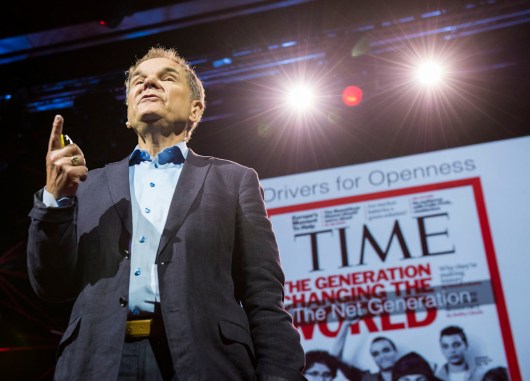When you hear the word “innovation,” an image may pop to mind of an intrepid inventor toiling in isolation — Benjamin Franklin flying his kite in a storm, or the Wright Brothers testing their flying machine on the beaches of Kitty Hawk. But during the first day of TEDGlobal 2012, speaker after speaker touted the tremendous leaps forward that can be made when we pool information, data, technology and insight over vast networks — and collectively share the task of creating and problem-solving. Almost all seemed to think that, when it comes to innovation, the more the merrier.
Digital visionary Don Tapscott (pictured above) kicked off the first session, “Critical Crossroads,” arguing that, since the time of the Gutenberg printing press, history has been moving toward shared intelligence. Giving recent examples ranging from business to the Arab Spring, Tapscott showed advances made by collectivity and pointed out ways that attempts to keep information and intellectual property private are being challenged. “This is not an information age, it’s an age of networked intelligence, an age of vast promise,” he said.
Tapscott found a beautiful analogy to highlight his point. “I’ve been studying nature recently. Bees come in swarms and fish come in schools, while starlings at night come together and create one of the most spectacular things in all of nature,” the astonishing starling murmuration, thousands of the birds dipping and diving together in a loose formation to protect themselves from predators. “There is leadership, but there is no leader. It’s an openness, a sharing of all kinds of information. I look at this thing and I get a lot of hope.”
Later in the first session, NATO Supreme Commander James Stavridis talked boldly about security in the 2st century, which he thinks will be best achieved by adopting an open-source model.
“Instead of building walls to create security, we need to build bridges,” he said. “Open-source security is about connecting the international, the interagency, the private and public — and lashing it together with strategic communication, largely in social networks. Open-source security is about connecting in ways that create longer lasting effect.”
In the second session of the day, “Tinker Maker Do,” the focus shifted from those who work in overarching systems to those who create something with their hands. Biologist Ellen Jorgensen sang the praises of do-it-yourself biotech labs, where anyone can have access to data and lab equipment.
She said, “You ask, ‘What would I do in a biotech lab?’ But it wasn’t long ago we were asking what would anyone do with a personal computer.”
Computing guru Massimo Banzi, the inventor of the Arduino, looked at the same effect with open-source hardware, sharing how, with simple microcontroller technology, users across the internet have shared plans for how to create, for example, a glove that translates sign language into words or a houseplant that tweets when it needs water.
Anti-poverty activist Jamie Drummond, the head of ONE.org, suggested that using group-think could also be valuable on a global political scale, revealing a plan to get mass participation in the setting of new worldwide Millennium Development Goals — targets set in the year 2000 to lower poverty and inequality and raise access to education worldwide by 2015. It’s likely these goals won’t be met by then, so “technocrats appointed by the UN and governments are busying themselves redesigning the goals, with the same 20th-century elite top-down closed process,” said Drummond. He would prefer that a global poll be taken on the issue, using the web and reality TV as information carriers.
In the final session of the day, “Building Blocks,” the focus shifted to education. Neuroscientist and artist Beau Lotto (watch his 2009 TEDTalk) shared his desire to open up scientific inquiry to a group not thought to have the intellectual rigor needed for it — children. Lotto showed how his students conducted an experiment to see if bees could problem-solve like humans. They wrote up their results in a proper scientific paper (though, yes, a scientific paper partially written in crayon) and — after two years of trying — it was published in a journal, and downloaded 30,000 times in its first day online.
“I learned that science isn’t just a boring subject,” said Amy O’Toole, age 12, one of the students who participated in the experiment (pictured below). “And that anyone can discover something new.”
Photos: James Duncan Davidson


Comments (1)